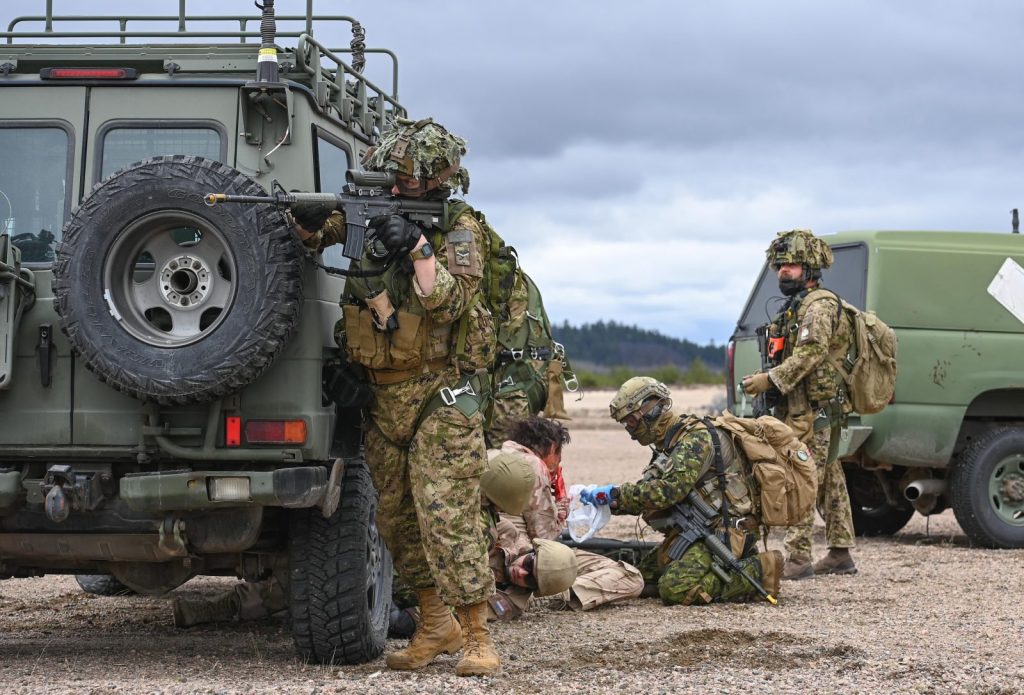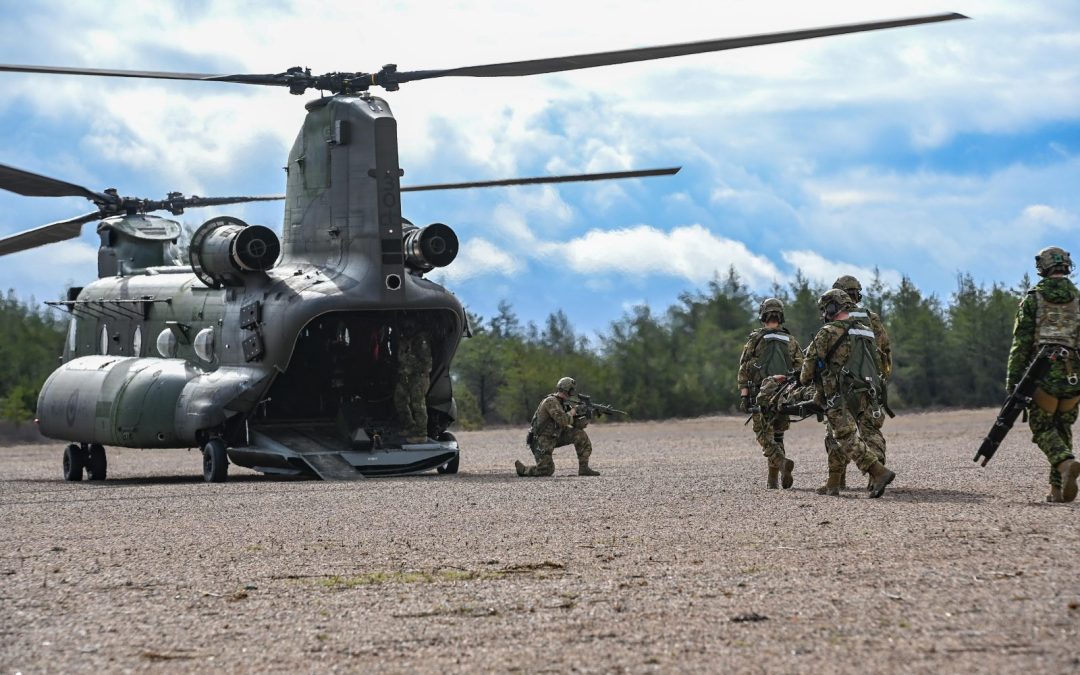by Chris Thatcher
As two Bell CH-146 Griffon helicopters alternated high and low sweeps overhead, a CH-147F Chinook cleared the treeline and rapidly descended into a clearing. Its wheels touched the gravel just long enough for a medical team and four force protection soldiers to clear the rear ramp, then it was airborne again, circling away to avoid ground fire.
The force protection detail quickly took up positions facing a cluster of trees and dense scrub. A technical vehicle had been spotted on a nearby road by the Griffons as they overflew the area on the route in and nobody was sure what lay within the forest. No sooner had the medics begun to treat four injured Dutch soldiers when gunfire erupted. The force protection team engaged, killing a half dozen members of a local militia who had struck the Dutch patrol earlier and were hoping to ambush the medical evacuation.
Once the medics had triaged the casualties and quickly prepped them for transport, the Chinook returned to the clearing while a Griffon established a protective hover. The force protection team helped load the patients, and the helicopter rapidly ascended away from any further ground fire. Onboard, the medical team of a flight surgeon, critical care nursing officer, and two aeromedical technicians went to work, assisted by the four infantry soldiers, to provide life-saving care, often communicating vital signs and other critical information with hand signals and notes on a grease pad, while the loadmaster and two door gunners maintained a watchful eye for activity below the aircraft.
The dynamic scenario was part of a validation exercise for the Canadian Medical Emergency Response Team (CMERT), held this past spring in the Petawawa training area at the end of a two-week course for the medical and force protection personnel, working alongside aircrews from 450 and 438 Tactical Helicopter Squadrons.
Forward aeromedical evacuation was developed and deployed to support the United Nations peacekeeping mission in Mali in August 2018. Over 12 months, teams of Chinook and Griffon crews, medical personnel, and force protection soldiers from the 3rd Battalion of the Royal 22ᵉ Regiment conducted 11 major medical flights involving over 40 patients under often difficult conditions. The success of the capability prompted a directive from the Vice Chief of the Defence Staff to make CMERT “an enduring capability.”
While 1 Wing Kingston holds responsibility for the overarching CMERT capability integration and 426 Transport Training Squadron is responsible for the training plan, the 3rd Battalion of the Royal Canadian Regiment (3 RCR) has been tasked with maintaining the force protection capability for at least the current year.
Since the Van Doos first stood up the capability of soldiers working simultaneously as a force protection detail and medical practitioners, responsibility for maintaining it has been passed among infantry units within the Army’s three mechanized brigade groups. When Oscar Company, 3 RCR, received the tasking, Captain Drew MacDonald-Wangen decided to experiment with how the force protection team was commanded.
Rather than depend solely on a command element from among the non-commissioned members on the detail, he opted to test a “role for the platoon command team within the scope of a potential CMERT mission. Rather than sitting on the sidelines and doing the administration for the team – sourcing ammunition, paperwork and coordination – I was looking for ways to involve myself and my platoon 2IC (second in command) in the actual mission if possible.”
During the validation exercise, as the force protection teams worked with their medical partners in the back of the Chinooks, MacDonald-Wangen took a seat in one of the Griffons to trial various command and control (C2) concepts to integrate an infantry perspective into the air picture.
From the escort helicopter, he tested different ways of relaying relevant information to the ground team that might not have always been apparent to tactical aviation pilots focused on flying the aircraft. While he had no direct command of their mission, he was able to share relatable details on ground elements such as the technical vehicles.
Griffon pilots, though used to working with the Army, “see things from 1,000 feet off of the ground,” he noted. “When you are up 1,000 feet it is more of a 2D picture. I was better able to put myself at ground level and see the 3D picture and how things might be influencing [the force protection detail]. To an Air Force pilot, a vehicle with a mounted machine gun acting as a technical may be a direct threat if it is moving toward the aircraft or in the general area. But I’m looking at how fast the vehicle is going and whether it can move to the point of injury and how long it will take for my team to form a defensive posture or prepare the casualties to be evacuated before the technical gets there. That was where we saw the big change.”
What and how an infantry officer conveys information is noticeably different, too, said Sergeant Adam Spencer, one of Oscar company’s section commanders.
“The differences were pretty big when it came to the type of information,” he said. “It is a more infantry-centric picture for us on the ground. And in the most basic language that I can understand. It worked out a lot better [and] I think a lot of the pilots took aboard a lot of the stuff he was passing on and said, ‘Maybe we should talk like that.’”
The CMERT role has been a constant evolution for the Army, MacDonald-Wangen noted, and the C2 component will be no different. The validation exercise proved the benefits of C2 from above, but it will have to be part of an “adaptable platform.”
CMERT missions are often away from other supporting elements, “so the idea was to add a command-and-control element for the force protection personnel from within the team on any given mission.” But because those missions are short-notice responses to a casualty, it might not always be possible or necessary to have a soldier’s perspective from the escort helicopter. “Depending on the mission, it might not make sense to tag along if it doesn’t require it. We’re also developing the scaling of the troops that are a part of force protection, whether it can be scaled up or down depending on the security,” he added.

Members of 3 RCR’s force protection team take up positions while medics treat a casualty. Photo: Cpl Melissa Gloude
A UNIQUE TASKING
For soldiers interested in the CMERT role, the Tactical Combat Casualty Care Course (TCCC) is a recommended perquisite, though not yet a requirement – 3 RCR would make it a necessary part of its pre-mission training if deployed because of the types of medical procedures the soldiers are asked to assist with, MacDonald-Wangen said. But beyond the validation exercise, CMERT does not require any specialized or enhanced infantry skills. “Our annual IBTS (individual battle task standards) training and battalion-led training will give them the skills and ability to do this tasking,” he said.
Learning the medical terminology and how to use specialized equipment such as a pelvic binder is part of the CMERT course. But “any individual from the battalion could be pulled into the group and trained up quickly for the scheme of manoeuvre for the mission and be able to execute it with no problems,” he noted. “If there is a mission, we have a plan for more focus on CMERT execution, but we wouldn’t have to pick individuals based on specific training.”
However, participation in CMERT has helped battalion members perform well on the TCCC and improved the overall understanding across the company of combat first aid. “It’s improving the infantry’s perspective on combat injuries,” said Spencer, noting the decline in specialized medical training since Afghanistan. “We haven’t focused on combat casualties like we used to, and I think we should incorporate a lot more into our training. The ripple effect from the exposure we have been getting by working with these doctors, nurses, and medics has been huge. Soldiers understand why a pelvic binder needs to be applied.”
It’s also having a noticeable effect on retention in the unit, he added. “This is something that everybody is super excited for. Who doesn’t want to ride in a helicopter? There were guys trying to get onto the CMERT tasking while we were doing [the validation exercise].”
Soldiers often seek job satisfaction from something different and this “is something unique that takes in all our previously learned skills and tests them in a different way,” said Macdonald-Wangen.
At present, 3 RCR holds the CMERT force protection responsibility until July 2023 – as well as a mandate for the Non-Combatant Evacuation Task Force. So far CMERT has been shared among the Army’s mechanized brigade groups, but there is an argument to leave 3 RCR as the permanent custodians of the capability because of its working relationship with 450 Squadron, the lead mounting unit for CMERT.
“Because of proximity, it does make sense for us to hold this mandate because we are able to continually train with them year-round,” said Macdonald-Wangen, noting the battalion already works with 450 Squadron to support the Basic Tactical Aircraft Control course twice each year.
But if the company does have to hand over the capability next year, they have been writing an aide memoire of sorts, a pocketbook adapting the lessons of their predecessors and their own experiences to pass on. “It will be a living document … [with] a lot of information,” he said. “It’s not yet an award-winning book, but it is a good baseline for others to be able to do {CMERT] off the hop.”


